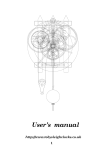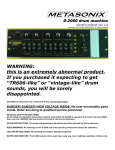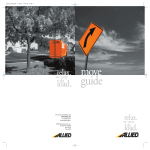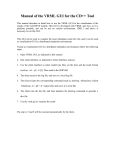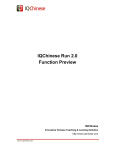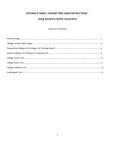Download Modular Rodent Exposure Unit
Transcript
Modular Rodent Exposure Unit Operation and Maintenance User Manual MODULAR RODENT EXPOSURE UNIT CONTENTS 1 2 3 4 5 Scope ................................................................................................................................. General Description ............................................................................................................ Operation of the Exposure Unit ........................................................................................... Maintenance and Cleaning .................................................................................................. Exposure Unit Parts ............................................................................................................. 2 2 5 6 9 1. Scope This section of the ONARES User Manual describes the operation and maintenance methods for the CH Technologies (Jaeger-NYU) Modular Nose-Only Directed-Flow Rodent Inhalation Exposure Unit. 2. General Description The CH Technologies Nose-Only Directed-Flow Rodent Inhalation Exposure Unit is modular system for nose-only exposure of mice, hamsters, rats, and guinea pigs. The modular exposure unit consists of stackable exposure tiers (Figure 1) plus top and bottom sections or plates for introduction and exhaust of test article. Each tier has 12 exposure ports which can be used for exposing up to 12 animals or sampling of test atmosphere. Each tier is made of an inner plenum and an outer plenum that are connected to each other through rectangular trumpets (tubes) and connector cones. All parts (except O-ring seals) are constructed of stainless steel. Exposure Tier Connector Cone Trumpet Figure 1. Partial View of Exposure Tier Showing Trumpet and Connector Cone Exposure Unit Page 2 of 9 5/16/07 The test animals are confined in polycarbonate containment tubes (examples shown in Figure 2) which are attached to the exposure ports by friction fit. Both sealed and vented containment tubes are available for mice, hamsters, rats, and guinea pigs. Vented Containment Tubes Sealed Containment Tube Figure 2. Examples of Animal Containment Tubes Fresh test atmosphere is provided to each animal from the inner plenum and exhausted into the space between the inner and the outer plenum (Figure 3). The test aerosol, gas, or vapor that flows through the inner plenum is distributed uniformly to the test animals through the trumpet. Exhaust (Upper swivel) Connector cone Trumpet Outer plenum Inner plenum Fresh Aerosol Exhaled Breath Test article inlet (Bottom swivel) Figure 3 The chamber is equipped with a bottom inlet section (plate) and a top exhaust section. Both sections are designed to connect easily to other equipment through swivels. Venturi tubes to measure the exposure unit inlet and exhaust flows may be included with the system. These attach at the inlet and exhaust of the unit. The venturi tubes are attached to pressure gauges which are calibrated to flow. If vented tubes are used, the chamber should be operated at a slightly positive pressure (i.e., the inlet flow should slightly exceed the exhaust flow) to assure that the test atmosphere is not diluted by air entering the animal containment tube. However, operating the system at a positive pressure may result in escape of test article from the exposure unit into the hood. If sealed animal containment tubes are used, the exhaust flow should be slightly higher than the inlet flow of the chamber. This will assure no escape of test article from the exposure unit. When the system is run with sealed animal containment tubes, the exhaust section is equipped with an air inlet (small filter) in order to make up for the flow difference between inlet and exhaust (Figure 4). Exposure Unit Page 3 of 9 5/16/07 Figure 4. Exhaust Section of Exposure Unit The chamber sits on a rotating table (Figure 5) that allows easy access to all nose ports. Rotating Table Figure 5. Single Tier Exposure Unit Mounted on Rotating Table Exposure Unit Page 4 of 9 5/16/07 3. Operation of the Exposure Unit 3.1. System Assembly 1. Refer to Section 4.3 for instructions on assembly of the exposure unit. 2. If inlet and exhaust flow venturi tubes are to be used, attach these to the inlet and exhaust of the exposure unit making sure that the inlet venturi is on the inlet of the exposure unit. Connect the venturi pressure tubes to the appropriate venturi tubes, making sure that they are in the proper order. They are color coded. 3. Connect the supply air tubing to the inlet of the exposure unit. 4. Connect the exhaust air tubing to the exhaust of the exposure unit. 5. Turn on the Off Exposure Air to a flow of about 500 ml/min for each test animal and sampler on the system. For a 24 port system, this amounts to a total off exposure air flow of 12 L/min If use rate of test article is an issue, the flow rate can be reduced to 250 ml/min for mice only. 3.2. Mounting Animals on Exposure Unit 1. Load animals into containment tubes and tighten pusher just tight enough to prevent the animal from turning around in the tube. If the pusher is too tight, it will impede the breathing of the animal. ! WARNING: Do NOT mount containment tubes with animals onto the exposure unit until Off-Exposure or Exposure Air has been turned on and adjusted to the proper flow. To do so may result in suffocation of the animals. 2. Mount the containment tubes onto the exposure unit exposure ports by pushing them slowly forward until the nose of the containment tube rests firmly against the internal wall of the connecter cone. ! ! WARNING: Do not use excessive force while pushing the tubes into the connector cone as this may cause tubes to crack or may damage the O-rings. WARNING: Make sure you plug all unused ports before starting exposure. Keep all the ports plugged after cleaning the chamber until the next round of exposure begins. Test article (either gas or particulate) has been shown to be evenly distributed to all nose ports of the exposure unit. Therefore, there is no specific recommendation of distribution of animals if fewer than the total number of ports are to be used. However it is preferable that the tubes be evenly spaced around the perimeter of the chamber. Any of the ports may be used for taking grab samples or for on-line aerosol concentration monitoring and temperature/relative humidity monitoring. TIP 3.3. Tip: When you expose the animals to aerosols, begin daily exposures with the control group of animals and progress from low dose groups to high dose groups. This exposure pattern limits cleaning of the exposure unit to only once at the end of exposure of all animal groups. Exposure Control The exposure unit is operated from the control panel. Three flow meters and flow controllers on the Flow Panel regulate the amount of air passing through the chamber and chamber pressure: The Vaporizer Air, Dilution Air, and Off Exposure Air). For operation of the test article generation devices, refer to the section of the manual pertaining to the particular generator being used. Exposure Unit Page 5 of 9 5/16/07 4. Maintenance and Cleaning 4.1. Disassembly Implement the following steps to disassemble the exposure chamber: 1. Disconnect the venturi tubes (if present) and swivels from inlet and exhaust plates. 2. Unscrew the exhaust tube from the top plate. 3. Carefully lift the exposure chamber from its resting place on the rotating table and place it on a clean working surface prepared beforehand. 4. Apply the lifting tool provided with your toolkit around the perimeter of the outer plenum to partially lift the top plate, then remove it by pulling it up with both hands. Use the same procedure to remove the inner plenum cap. 5. Flip the chamber upside-down and remove the bottom plate. 6. Using the lifting tool, separate the tiers from each-other. The tiers can be further disassembled into their constituent parts for deep cleaning or maintenance purposes. However, this process requires specialized personnel and it is not recommended to be performed on a routine basis. If a total disassembly is needed, please consult the CH Technologies technical support staff first. To totally disassemble the tiers do the following: 7. Unscrew the connector cones from their holes in the outer plenums of both tiers. 8. Unscrew all the trumpets from the inner plenums of both tiers using the special socket wrench provided with the toolkit. 9. Remove all the O-rings from inner plenums, outer plenums, connector cones, and the plates. 4.2. Cleaning The cleaning schedule of the exposure unit will depend on their utilization regimen. If the system is used for vapor inhalation, it is not necessary to clean the chamber daily, but a thorough cleaning should be performed before starting the exposure with a new/different test article. However, if powders, liquid aerosols or cigarette smoke are used, cleaning is required at the end of every exposure day. A thorough daily cleaning is particularly required after exposure to cigarette smoke. Cleaning with a mild soap solution in warm water is generally adequate. Depending on the test article used, special solvents may be used in certain cases. Be sure that the O-rings are compatible with any solvents used. Special chemical resistant O-rings are available from CH Technologies. Clean the lumen of the trumpets with a cotton swab. Distilled water is a good choice for the final rinse; warm tap water may work also. You must judge the success of your cleaning/rinsing with your own QA/QC wipe tests or similar assessments. While it is not recommended that chamber parts be cleaned in a dishwasher or cage washer, it is possible to use such a procedure if you desire. However, if you opt for automatic cleaning, you should first contact CH Technologies in order to establish appropriate guidelines for cleaning under high pressure and hot water at alkaline pH. ! Exposure Unit WARNING! If automatic washing is not carried out properly, it may cause mechanical damage and/or chemical corrosion to the sealing surfaces of various system parts. Page 6 of 9 5/16/07 Each time the chamber is disassembled, the threads should be cleaned, inspected for wear or corrosion, and taped with Teflon or lubricated with the sealant materials; e.g. vacuum grease, Teflon emulsion, etc., provided with your toolkit. ! WARNING! Be aware of the possibility of cross threading when assembling parts with threads. Check all threads for hidden debris. O-rings should be inspected during each cleaning. The slightest tear or cut on the O-rings will result in an inappropriate sealing of the chamber parts, and may result in leaking of the test article into the air. Even when the O-rings don’t appear to be damaged, used O-rings should be changed at frequent intervals because they deteriorate with time. Lubricate them as required when you reassemble the chamber. The cleaned chamber parts should be allowed to air dry or they may be dried with warm forced air. They should be lubricated as required and reassembled with careful attention to sealing surfaces. Pressure tests (leak checks) and system integrity should be verified. A detailed log should be maintained with the cleaning schedule and results of the leak tests. 4.3. Reassembly Follow these steps to reassemble the chamber from a total disassembled state: 1. On a clean work surface, place the inner plenum inside the outer plenum and align their holes. 2. Apply a small amount of lubricant to the threads of a trumpet, and with the help of the special socket wrench provided, insert it through a connector hole in the outer plenum and screw it into the inner plenum. 3. Using the same procedure, insert two more trumpets into the inner plenum, spaced evenly around its circumference, to make sure that the inner and outer plenums are correctly aligned. TIP The fingers may be needed to manipulate the trumpet into position and to begin screwing it in place. However, once this is done, the socket wrench can be used finish screwing the trumpet into the inner plenum quickly. 4. Insert two of the small, slightly more rigid O-rings into the grooves in the inside of three connector cones and apply a small amount of lubrication directly to their threads. 5. Screw the connector cones into the holes in the outer plenum that are aligned with the three trumpets in the inner plenum. ! WARNING: Do NOT over tighten the connector cones! Simple hand pressure is usually enough to properly assemble the unit. The amount of pressure that can be applied with a wrench is generally greater than that which is required. 6. Repeat steps 2 through 5 for the remaining 9 ports of the exposure tier. 7. Repeat steps 1 through 6 for all other exposure tiers. After you have assembled the individual tiers, continue with the following procedure to put the exposure unit together. If you have not totally disassembled your exposure unit, you may start here with the reassembling procedure: 8. Using a cotton swab, lubricate the top and bottom ridges of the inner and outer plenum of the assembled tiers. 9. Lubricate the grooves in the bottom plate in the same manner. Exposure Unit Page 7 of 9 5/16/07 10. Remove any excess lubricant by wiping the mentioned surfaces with a paper towel or a clean cloth. 11. Place one large O-ring into the groove in the outer plenum and a smaller O-ring into the groove of the inner plenum on both tiers. 12. Using another cotton swab, apply a small amount of lubrication to the surface of the Oring of one of the tiers to allow the rings to rotate freely with respect to each other. Gently rest the first tier in the proper grooves in the base plate WITHOUT pushing down. Rotate the tier several times while resting it on the grooves to assure that both surfaces are properly lubricated. ! WARNING: Do not push the tier down onto the bottom plate without first rotating it several times. If you do so, you will risk cutting or pinching the Orings. 13. Next, firmly press the tier down into the bottom plate, making sure that the O-rings remain in the groove to avoid cutting it. A click should be heard, indicating that the tier is properly seated. 14. Repeat steps 8 through 13 to connect the subsequent tiers on top of the previous one. 15. Applying the laboratory grade silicone sealant with a cotton swab, lubricate the portion of the inner plenum cap that will connect to the inner plenum. 16. Next, place the O-ring in the groove in the inner plenum cap and lubricate the O-ring surface. 17. Position the cap in place and press down firmly until the click is heard. Once again, make sure that the O-ring remains in the groove to avoid cutting it. 18. Apply silicone sealant to the ridge of the top plate with another cotton swab. 19. Place the second large O-ring into the groove in the top plate's ridge. 20. Lubricate the surface of the O-ring and remove the excess. Place in proper position and press down firmly, once again making sure not to cut the O-ring. The click will indicate a secure fit. Exposure Unit Page 8 of 9 5/16/07 5. Exposure Unit Parts Exposure Unit Page 9 of 9 5/16/07











